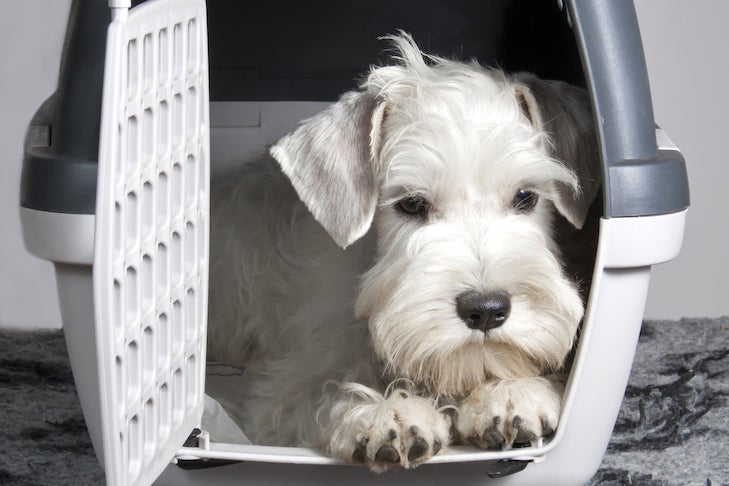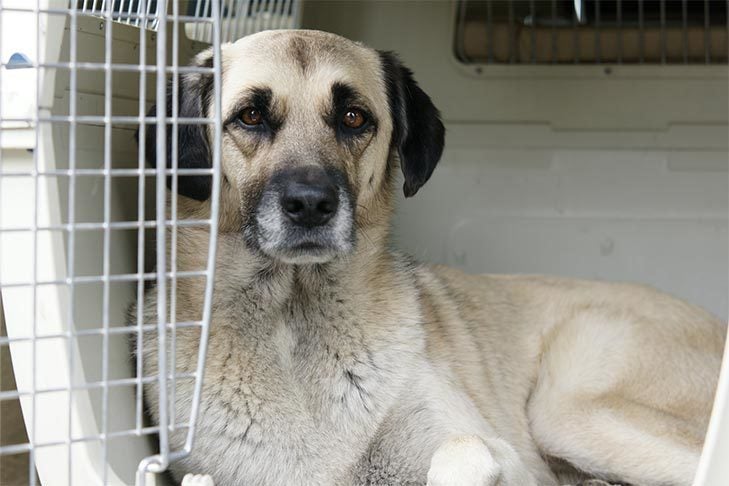
AKC is a participant in affiliate advertising programs designed to provide a means for sites to earn advertising fees by advertising and linking to akc.org. If you purchase a product through this article, we may receive a portion of the sale.
Crate training is a vitally important part of bringing a dog of any age into your life and home. It can benefit puppies, adult dogs, and seniors in one way or another. Crate training can give dogs a sense of security and give owners more peace of mind.
Breeders and Vets Recommend Crate Training Your Dog
Enclosed spaces create a shelter for your dog to rest and relax. Actually, dogs instinctively seek small spaces to create protective shelters for themselves. Crates are useful training tools for puppies, safe havens for senior dogs, and lifesavers for emergencies.
Most veterinarians, trainers, and breeders recommend crate training dogs from a young age. Crate training is an essential part of housebreaking puppies, as dogs don’t like to soil their sleeping quarters. They learn to hold their bladders while they’re in their crate, so you won’t have to clean up messes.
“We recommend crate training every dog because you never know what’s going to happen in the future,” says Christine Kroh, intake coordinator at Beagles to the Rescue.

In emergencies, crate training can be the difference between safety and uncertainty. You must be able to evacuate your dog efficiently, so having a cooperative dog get into a crate quickly saves crucial time. Having dogs secured during evacuations reduces the chance of them getting lost or injured. It also allows your dog to stay with you during an emergency because dogs typically have to be crate trained in order to remain in shelters with their owners.
Crate Training Makes Life Easier
For dogs that aren’t crate trained, crates may be the scariest part of a harried situation. Crate training can help prevent compounding a dog’s stress during emergencies. In worst-case scenarios, dogs may be required to be on crate rest when recovering from surgery. Dogs are less likely to have complications following surgery when they can peacefully relax (rather than accidentally aggravate injuries because they can’t settle down in a crate).
Crate training comes in handy during everyday life. Some dogs might need a break from a bustling household or a familiar place to rest. Crates help dogs learn to self-soothe or deal with their anxiety during situations where they become distressed, like during fireworks, thunderstorms, or construction. Dogs can retreat to their crates when situations are too chaotic or scary. Crate training also helps dogs confront new situations successfully, like the addition of a new baby or having company over.

“If the dog’s freaking out, they think, ‘I can go hide in my crate and it’s safe here and nobody’s gonna bother me.’ That helps them out for their lifetime,” says Kroh.
Crates make it easier to safely transport your dog by car or by air during long-distance travel or vacations. Crate training makes long car rides more pleasant for both humans and canines. Crates allow dogs to lie down and sleep without distracting the driver.
It’s especially important for a dog to know how to behave in a crate during a flight. Many dogs need to be contained if they travel on airplanes. The American Veterinary Medical Association notes that sedation isn’t necessarily recommended for pets traveling on planes, but you should discuss the matter with your vet well in advance of flying with your dog.
Crate Training Benefits Dogs of All Ages
Crates keep curious puppies safely sequestered when you’re not able to supervise them. Dogs instinctively try to keep their sleeping areas clean. As such, the crate helps puppies learn to hold and strengthen their bladder and bowel muscles, making housebreaking less of a chore for you and your dog.
“When they’re puppies, the crate really is the major tool that will help you house train,” says trainer Heike Purdon. “It teaches them that freedom is a privilege and you get more space as your house training skills become better.”

Crate training early in a dog’s life prevents introducing unnecessary stress later. When older dogs are dealing with illnesses like incontinence, arthritis, or canine cognitive dysfunction, they don’t need the additional stress of learning new rules.
Crate training helps senior dogs deal with health issues. Crates can provide a restful place for senior pets to rest their joints or take frequent naps, prevent nighttime wandering, and make transporting them to vet appointments easier. Crates also create safe havens for older dogs, who may be especially in need of this when surrounded by rambunctious children or other dogs.
Crate Training Benefits All Types of Dogs
For rescued dogs, a crate provides a safe space to adjust to their new surroundings as well as the luxury of not having to fight for their own space. Crates provide comfort to rescued dogs, since they may be fearful around certain people or environments. This is particularly true for dogs with a traumatic past of neglect or abuse. Crates allow rescued dogs to know they have their own territory and no one will hurt them in it.
Kroh notes that the biggest behavior issues they see with rescued dogs “are barking and being destructive.” Many rescued dogs haven’t yet sufficiently developed their socialization skills, which can result in problems with destruction or barking. Crate training will improve their confidence and curtail problematic behavior.

Crate training benefits hunting dogs, keeping them comfortable during hunts and on the road. Of course, this also benefits hunters, since they’ll appreciate having wet and muddy dogs contained. Kroh advises crate training hunting dogs the same way you would a puppy.
Since dogs feel responsible for their own territory, insecure dogs need less space to protect. A crate (rather than the entire house) means less territory to patrol, making it easier for your dog to relax.
Tips for Successful Crate Training
The first and most important step in crate training is making it a positive experience. Try feeding them meals or treats in their crate so crate time feels like a reward. Never leave dogs in their crate all day. Limit your dog’s crate time based on how long they spend there daily, their age, and their level of house training.
Understanding the need for crate training is just the first step, but the training itself is another matter entirely. Make sure to do extensive research on how to crate train your dog, consider consulting a dog trainer if you have questions, and be sure to stick to your plan to ensure the greatest chance of success.

